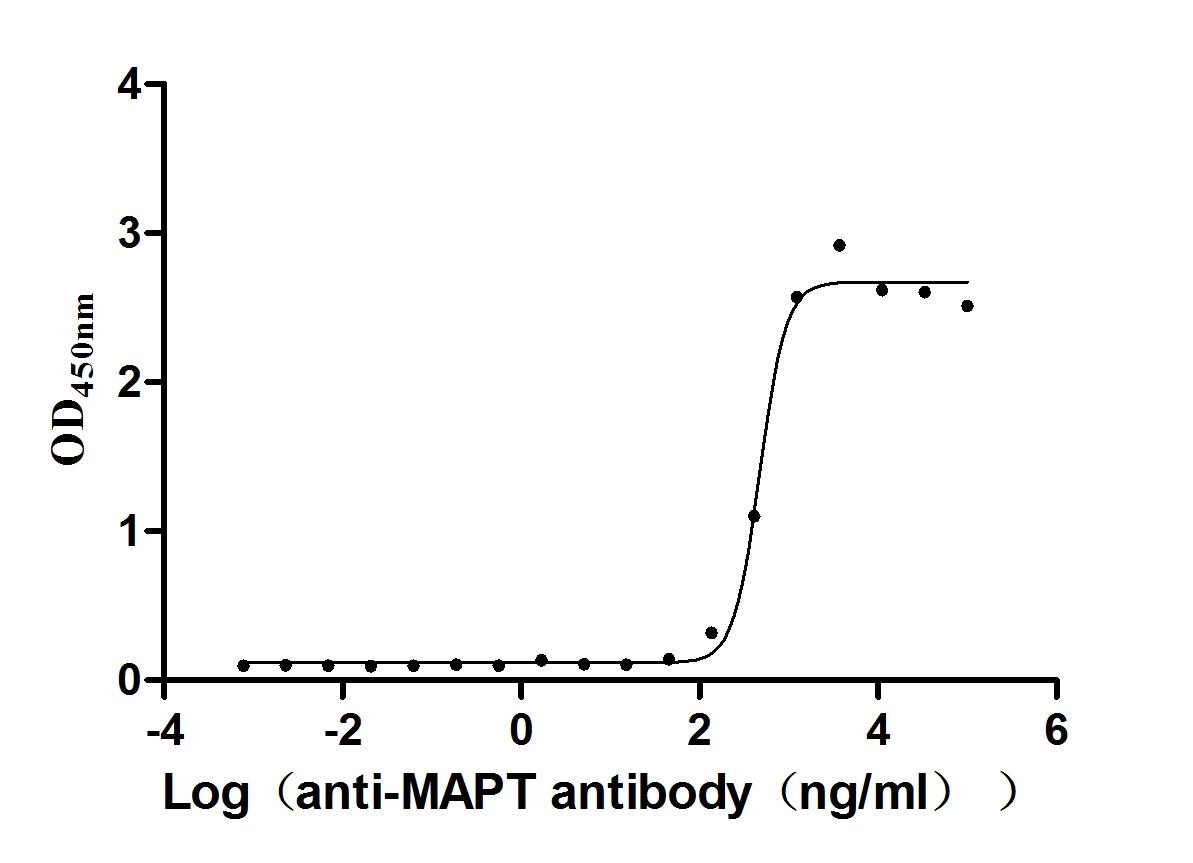Recombinant Mouse Apoptosis-stimulating of p53 protein 2 (Tp53bp2), partial
-
中文名稱:小鼠Tp53bp2重組蛋白
-
貨號:CSB-YP804507MO
-
規(guī)格:
-
來源:Yeast
-
其他:
-
中文名稱:小鼠Tp53bp2重組蛋白
-
貨號:CSB-EP804507MO
-
規(guī)格:
-
來源:E.coli
-
其他:
-
中文名稱:小鼠Tp53bp2重組蛋白
-
貨號:CSB-EP804507MO-B
-
規(guī)格:
-
來源:E.coli
-
共軛:Avi-tag Biotinylated
E. coli biotin ligase (BirA) is highly specific in covalently attaching biotin to the 15 amino acid AviTag peptide. This recombinant protein was biotinylated in vivo by AviTag-BirA technology, which method is BriA catalyzes amide linkage between the biotin and the specific lysine of the AviTag.
-
其他:
-
中文名稱:小鼠Tp53bp2重組蛋白
-
貨號:CSB-BP804507MO
-
規(guī)格:
-
來源:Baculovirus
-
其他:
-
中文名稱:小鼠Tp53bp2重組蛋白
-
貨號:CSB-MP804507MO
-
規(guī)格:
-
來源:Mammalian cell
-
其他:
產(chǎn)品詳情
-
純度:>85% (SDS-PAGE)
-
基因名:
-
Uniprot No.:
-
別名:Tp53bp2; Aspp2; Trp53bp2Apoptosis-stimulating of p53 protein 2; Tumor suppressor p53-binding protein 2; 53BP2; p53-binding protein 2; p53BP2
-
種屬:Mus musculus (Mouse)
-
蛋白長度:Partial
-
蛋白標(biāo)簽:Tag?type?will?be?determined?during?the?manufacturing?process.
The tag type will be determined during production process. If you have specified tag type, please tell us and we will develop the specified tag preferentially. -
產(chǎn)品提供形式:Lyophilized powder
Note: We will preferentially ship the format that we have in stock, however, if you have any special requirement for the format, please remark your requirement when placing the order, we will prepare according to your demand. -
復(fù)溶:We recommend that this vial be briefly centrifuged prior to opening to bring the contents to the bottom. Please reconstitute protein in deionized sterile water to a concentration of 0.1-1.0 mg/mL.We recommend to add 5-50% of glycerol (final concentration) and aliquot for long-term storage at -20℃/-80℃. Our default final concentration of glycerol is 50%. Customers could use it as reference.
-
儲存條件:Store at -20°C/-80°C upon receipt, aliquoting is necessary for mutiple use. Avoid repeated freeze-thaw cycles.
-
保質(zhì)期:The shelf life is related to many factors, storage state, buffer ingredients, storage temperature and the stability of the protein itself.
Generally, the shelf life of liquid form is 6 months at -20°C/-80°C. The shelf life of lyophilized form is 12 months at -20°C/-80°C. -
貨期:Delivery time may differ from different purchasing way or location, please kindly consult your local distributors for specific delivery time.Note: All of our proteins are default shipped with normal blue ice packs, if you request to ship with dry ice, please communicate with us in advance and extra fees will be charged.
-
注意事項:Repeated freezing and thawing is not recommended. Store working aliquots at 4°C for up to one week.
-
Datasheet :Please contact us to get it.
靶點詳情
-
功能:Regulator that plays a central role in regulation of apoptosis and cell growth via its interactions with proteins such as TP53. Regulates p53/TP53 by enhancing the DNA binding and transactivation function of p53/TP53 on the promoters of proapoptotic genes in vivo. Inhibits the ability of APPBP1 to conjugate NEDD8 to CUL1, and thereby decreases APPBP1 ability to induce apoptosis. Impedes cell cycle progression at G2/M. Its apoptosis-stimulating activity is inhibited by its interaction with DDX42.
-
基因功能參考文獻(xiàn):
- These results suggest that ASPP2 plays an important role in p53-mediated neuronal apoptosis under gp120 stress. PMID: 27625111
- These findings identify TP53BP2 as a strong candidate causative gene for central nervous system (CNS) defects in 1q41q42 microdeletion syndrome. PMID: 27447114
- SPP2 dominates the biological outcome, thus switching from a Gal-1 supported growth-promoting setting to a senescence inducing and stemness suppressive program in cancer cells. Our results support Ras nanocluster as major integrators of tumour fate decision events. PMID: 27437940
- ASPP2 may participate in the lipid metabolism of non-alcoholic steatohepatitis and attenuate liver failure. PMID: 25256142
- ASPP2 prevents beta-catenin from transactivating ZEB1 directly by forming an ASPP2-beta-catenin-E-cadherin ternary complex PMID: 25344754
- findings suggest that the identified STAT1/ASPP2 pathway may connect tumor suppression and cell polarity to neuroinflammation PMID: 24958857
- our studies demonstrate the role of Siah2 in regulation of tight junction integrity and cell polarity under hypoxia, through its regulation of ASPP2 stability. PMID: 23644657
- ASPP2 is a tumor suppressor that suppresses squamous cell carcinoma via inflammatory signaling through NF-kappaB-mediated repression of p63. PMID: 24127607
- Our study demonstrates a novel role for ASPP1 and ASPP2 in the death of retinal ganglion cells. PMID: 23365256
- regulates epithelial cell polarity in cooperation with PAR-3 to form an active PAR complex PMID: 20619648
- Consistent with its role in cell polarity, ASPP2 influences interkinetic nuclear migration and lamination during CNS development. PMID: 20619750
- ASPP2 is a haploinsufficient tumor suppressor that shares overlapping function(s) with p53 in mouse development and tumor suppression. PMID: 16702401
- 53BP2S interacts and modulates the insulin signals mediated by insulin receptor substrates. PMID: 17965023
- ASPP2(+/-) mice appeared developmentally normal, they displayed an increased incidence of a variety of spontaneous tumors as they aged PMID: 19251665
- [review] potential ASPP2-mediated pathways found by gene expression profiling PMID: 19657229
顯示更多
收起更多
-
亞細(xì)胞定位:Cytoplasm, perinuclear region. Nucleus.
-
蛋白家族:ASPP family
-
數(shù)據(jù)庫鏈接:
Most popular with customers
-
Recombinant Human Pro-neuregulin-1, membrane-bound isoform (NRG1), partial (Active)
Express system: Mammalian cell
Species: Homo sapiens (Human)
-
Recombinant Human Neuropilin-1 (NRP1) (Active)
Express system: Mammalian cell
Species: Homo sapiens (Human)
-
Recombinant Mouse Microtubule-associated protein tau (Mapt) (Active)
Express system: Mammalian cell
Species: Mus musculus (Mouse)
-
Recombinant Human C-X-C chemokine receptor type 4 (CXCR4)-VLPs (Active)
Express system: Mammalian cell
Species: Homo sapiens (Human)
-
Recombinant Mouse Cytotoxic and regulatory T-cell molecule (Crtam), partial (Active)
Express system: Mammalian cell
Species: Mus musculus (Mouse)
-
Recombinant Human Myosin regulatory light chain 12B(MYL12B) (Active)
Express system: E.coli
Species: Homo sapiens (Human)
-
Recombinant Human Mucin-13(MUC13),partial (Active)
Express system: yeast
Species: Homo sapiens (Human)


-AC1.jpg)


-AC1.jpg)











